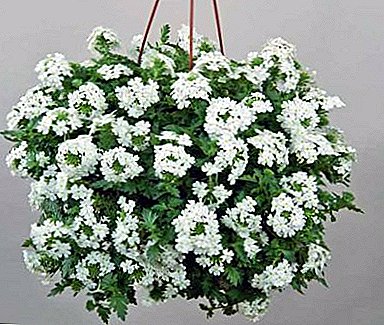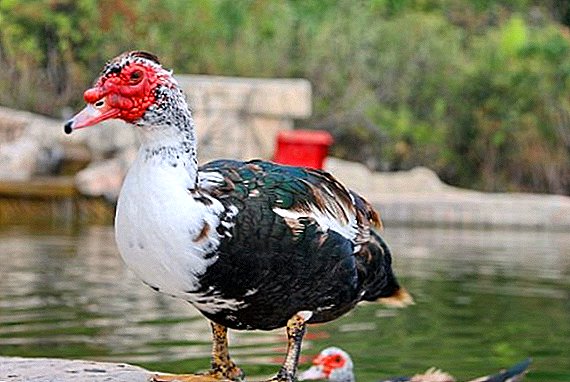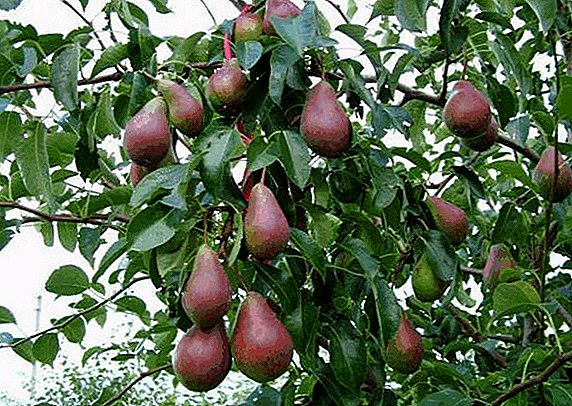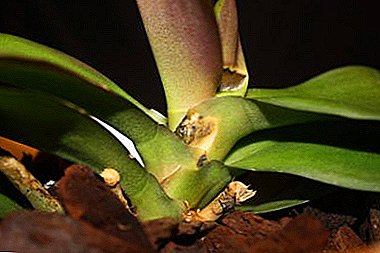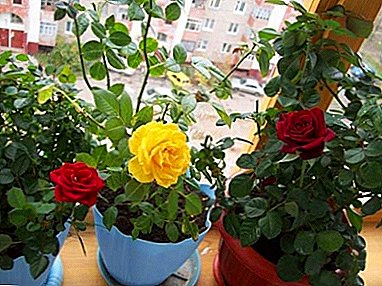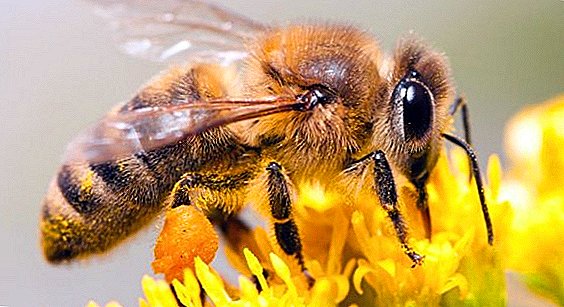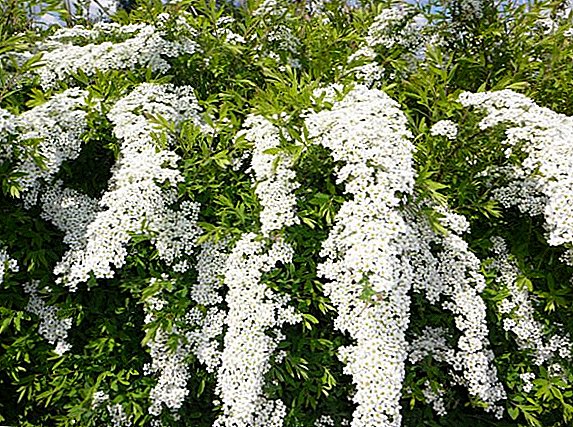 There are about a hundred species of spirea shrubs. They differ in the crown, shape and color of leaves and inflorescences, but they all share one thing: a gorgeous appearance. For planting plants in your garden or in the yard will be useful to learn about the main types of spirea.
There are about a hundred species of spirea shrubs. They differ in the crown, shape and color of leaves and inflorescences, but they all share one thing: a gorgeous appearance. For planting plants in your garden or in the yard will be useful to learn about the main types of spirea.
Spring blooming spirea group
A group of spring-flowering species consists of spireas, which bloom on the shoots of the previous year of life, and the flowers often have a white color. The flowering season of spring spiraeus begins in late May and early June and lasts about three weeks.
Did you know? Rod spirea belongs to the family pink. Its Latin name is derived from the Greek word "speira" ("bend") due to the presence of gracefully curving branches.
Spiraea Argut (Spiraea x arguta)
 This kind of spirea is a hybrid of the spirea species of Thunberg and the spirea of many-flowered.
This kind of spirea is a hybrid of the spirea species of Thunberg and the spirea of many-flowered.
The height of the bush reaches two meters. The crown is wide and lush. Dark green leaves have a narrow shape. White flowers with a diameter of 0.8 cm are connected to numerous inflorescences in the form of an umbrella, covering elegant arcuate twigs.
The earliest of the group of spring flowering spireas. Argut spirea (or sharp-toothed) blooms every year and looks beautiful in the form of a hedge, with a single planting and in combination with other plants. It tolerates slightly dry soil, but good lighting is necessary.
Spiraea oak (Spiraea chamaedryfolia)
 Spiraea oak ˜- shrub up to two meters, with a rounded dense crown and long ribbed shoots. In nature, prefers stony and mountainous terrain, the area of growth - from Eastern Europe to the Far East.
Spiraea oak ˜- shrub up to two meters, with a rounded dense crown and long ribbed shoots. In nature, prefers stony and mountainous terrain, the area of growth - from Eastern Europe to the Far East.
Oblong peaked leaves are bright green above and gray below with teeth to the base. White flowers of a spirea are connected in hemispherical inflorescences. This species is highly resistant, demanding of soil and lighting.
Spiraeus Wangutta (Spiraea x vanhouttei)
 Result hybridization of Cantonese and three-blade spirea species.
Result hybridization of Cantonese and three-blade spirea species.
Vagutta Spirea Bush very large: its diameter and height are two meters. The shape of the crown - a cascade of sprawling arcuate branches. Along the entire length of the shoot there are a lot of hemispherical inflorescences of small white flowers.
Sometimes the spirea Vangutta blooms second time - in August. It looks beautiful in large flower beds, as well as in the landscape with coniferous trees and near water bodies. Loves well lit places and drained soil.
Important! Spirea plants are good honey plants, hives can be placed on their landing sites.
Spiraea Crenata (Spiraea crenata)
 It grows in the south-east of Western Europe and Russia, in the Caucasus, Altai and the north of Central Asia.
It grows in the south-east of Western Europe and Russia, in the Caucasus, Altai and the north of Central Asia.
Spirey - small shrub (about 1 m). The distinctive features of the species are the dislocated edge of the leaves and the presence of three veins below. The leaves are grayish-green, the flowers are white with a shade of yellow, the inflorescences are broad and corymbose.
This species is not very common in culture. In nature, spiraea mayotate grows in thickets on rocky mountain slopes and in meadow, shrub steppes.
Spiraea nipponica (Spiraea nipponica)
 Homeland of this species - Japan.
Homeland of this species - Japan.
The bush has a height of two meters. His crown is thick and spherical, the branches spread horizontally. Spirey Nippon blooms in early June, the buds are purple, and the flowers are cream. Large complex inflorescences densely cover the branches. Green leaves retain their color until late autumn.
Spiraea Nipponskaya is good at single landing and in the hedge. It is unpredictable to the soil, but it requires lighting. There are two decorative forms: round-leaved and narrow-leaved.
Did you know? The name of the drug "aspirin" comes from the word "spirea". In the 19th century, acetylsalicylic acid was first isolated from the leaf-bearing meadowsweet (Filipnedula ulmaria), at that time classified into the spiraea (Spiraea ulmaria).
Spirea Thunberg (Spiraea thunbergii)
 Very decorative Thunberg spirea bush in height reaches 1.2-1.5 meters. Crown shrub openwork, with thin thick branches. The leaves are very thin and narrow (length 4 cm, width 0.5 cm); in spring they are yellow, bright green in summer, and orange in autumn.
Very decorative Thunberg spirea bush in height reaches 1.2-1.5 meters. Crown shrub openwork, with thin thick branches. The leaves are very thin and narrow (length 4 cm, width 0.5 cm); in spring they are yellow, bright green in summer, and orange in autumn.
At the base of the umbellate inflorescence with few flowers is a rosette of small leaves. The flowers are white with oval petals on thin stalks. Spirea Thunberg blooms in May before the leaves appear.
She loves the light and gives preference to sunny planting places, soil and watering unpretentious. In harsh winters, shoots can frost up, but this species is quite frost resistant.
Spiraea gray (Spiraea x cinerea)
 Gray spirea bred as a result hybridization of spiraea and beast-whitish spirea and whitish-gray in Norway in 1949.
Gray spirea bred as a result hybridization of spiraea and beast-whitish spirea and whitish-gray in Norway in 1949.
It got its name because of the shade of the leaves: they are gray-green at the top and slightly lighter at the bottom, in autumn they turn to faded yellow. The inflorescences are also gray on the underside, and the flowers themselves are white. Bush height - 1.8 m.
The main pest of the spirea sulfur is the snail. The most famous variety of gray spirea is Grefsheim (Grefsheim). It is distinguished by a wide, rounded crown, very thin, beautifully arched shoots and long flowering.
Spirea Grefshaym unpretentious to the composition of the soil and light, in the shade it just does not bloom so abundantly. It is cold-resistant and can be grown in climates with low winter temperatures.
Important! A beautiful composition creates a combination of gray spirea bush with multi-colored tulips, daffodils, crocuses, primroses, alissums. The graceful hedge will turn out from the bushes of a spirea of one or different types planted along a fence or a grid.
Spiraea average (Spiraea media)
 Spirea average - very branched shrub with a height of two meters and a diameter of 1.2 meters. The crown is round and dense, the shoots are brown with a red or yellow tinge, with flaky bark, round and bare.
Spirea average - very branched shrub with a height of two meters and a diameter of 1.2 meters. The crown is round and dense, the shoots are brown with a red or yellow tinge, with flaky bark, round and bare.
The leaves of the middle spirea are oval-oblong, with short petioles, with teeth on top, bright green. White flowers are collected in corymbose inflorescences. The flowering period is 15-20 days in May. In nature, it grows in thickets, on dry slopes.
Spiraea livolistnaya (Spiraea prunifolia)
 Naturally found in China and Korea. The height of the shrub is up to two meters, the branches are thin, twig-shaped. Bright green leaves have an oval-oblong shape, with a sharp apex and narrowed base.
Naturally found in China and Korea. The height of the shrub is up to two meters, the branches are thin, twig-shaped. Bright green leaves have an oval-oblong shape, with a sharp apex and narrowed base.
In the fall they become reddish brown or orange. 3-6 white terry flowers with thin pedicels are combined into umbrellas-inflorescences with a rosette of small leaves.
To frosts, the species is poorly resistant. For planting, it is recommended to choose a windless place in the penumbra or in the sun, the optimum soil is moderately wet, with no lime content.
Did you know? The species was first described in 1840 by the Germans Philip von Siebold and J. G. Zuccarini in the book Flora of Japan.
Summer blooming spirea group
Plants of this group are distinguished by the fact that their corymbose and pyramidal inflorescences are formed on young shoots that dry out the following year. Flowering begins in June, the flowers have red-pink shades.
Japanese Spirea (Spiraea japonica)
 Japanese spirea bush reaches a height of 1.5 meters, it is slow-growing and straight. In autumn, its leaves are painted in rich shades of orange flowers. The leaves are oblong and with teeth along the edge; small pink flowers are gathered in wide shields. The period of abundant flowering - from late June to mid-August.
Japanese spirea bush reaches a height of 1.5 meters, it is slow-growing and straight. In autumn, its leaves are painted in rich shades of orange flowers. The leaves are oblong and with teeth along the edge; small pink flowers are gathered in wide shields. The period of abundant flowering - from late June to mid-August.
This species is not particularly picky about the conditions of detention, but it feels better in sunny places and in moist soil. The plant is frost-resistant and can do without special shelter.
Many varieties of Japanese spireas have been developed: Little Princesses (Little Princess), Shiroban, Macrophylla, Candlelight, Goldflame, Golden Princess, Gold Mound.
The low-growing shrub of the Japanese Goldflame variety spirea (height - 0.6-0.8 m, diameter up to 1 m) first has an orange-red or bronze-golden color of young leaves, and later a bright yellow one. During the flowering period, the leaves acquire a yellow-green shade, in the fall - copper-orange with a golden hue.
Did you know? On one inflorescence of a spirea of a grade of Shiroban there can be flowers of snow-white, pink and lilac-red shades.
Spiraea Douglas (Spiraea douglasii)
 Motherland douglas spireas - North America. The shrub has a height of up to 1.5 meters. His shoots are straight, pubescent, reddish-brown. Leaves up to 10 cm long, narrow and oblong, with teeth at the top, green and silvery on the other side.
Motherland douglas spireas - North America. The shrub has a height of up to 1.5 meters. His shoots are straight, pubescent, reddish-brown. Leaves up to 10 cm long, narrow and oblong, with teeth at the top, green and silvery on the other side.
Pyramidal narrow inflorescences-panicles collected from bright pink flowers.
It grows well in the sun and in partial shade. It blooms from July to September. A beautiful bush of Douglas Spirea will look spectacular in group plantings along park roads, it has the ability to fix slopes and areas destroyed by water and wind.
Spiraeus Bumald (Spiraea x bumalda)
 This hybrid of Japanese spirea and white flowered spirea often found in culture. Spinea Bush - compact and low (0.75-1.0 m), crown of spherical shape, the branches are straight.
This hybrid of Japanese spirea and white flowered spirea often found in culture. Spinea Bush - compact and low (0.75-1.0 m), crown of spherical shape, the branches are straight.
Young shoots are green, bare and slightly ribbed, later becoming reddish-brown with flaky bark. Leaves ovate-lanceolate form. The flowers are painted in different shades of pink - from light to dark. Inflorescences are flat and corymbose.
Several varieties (Anthony Waterer, Gold flame, Darts Red) and decorative forms (“dark pink”, “curly”, “graceful”, etc.) of Bumald spiraei have been developed. This type of winter-hardy and picky to the soil, but in the dry season need a good watering.
Important! Spiraea Bumald and Douglas need careful annual pruning. In the first year, the main and branches growing inside the bush are pruned, and the next year they monitor the crown shape.
Spiraeus Billard (Spiraea x billardii)
 Spirea billard created by hybridization of varieties of Douglas and Spiraea wolfish spireas. Shrub reaches a height of more than two meters.
Spirea billard created by hybridization of varieties of Douglas and Spiraea wolfish spireas. Shrub reaches a height of more than two meters.
The leaves are long (up to 10 cm) and sharp, in the form of a lancet, like that of a willow leaf spirea. Long and fluffy inflorescences-panicles of pink flowers - a reminder of the second variety, Douglas spirea.
It blooms in July and August, and the flowers fall off after the first frost. It is a very frost-resistant spirea and feels good in the cold northern regions. Looks great in a hedge.
Spiraea birchwood (Spiraea betulifolia)
 Naturally grows in the Far East, in Japan and Korea, in Eastern Siberia. The shape of the leaves of this species resembles the shape of birch leaves - oval with a wedge-shaped base, for which it received its name.
Naturally grows in the Far East, in Japan and Korea, in Eastern Siberia. The shape of the leaves of this species resembles the shape of birch leaves - oval with a wedge-shaped base, for which it received its name.
In autumn, the green leaves become bright yellow. The low-growing shrub of the birch-leaved spirea (60 cm high) has a spherical dense crown and ribbed, sometimes zigzag-curved shoots. Inflorescences have the form of a dense panicle of numerous white or pinkish flowers. Flowering begins in June.
In nature, shrubs grow in coniferous and mixed forests on the slopes of mountains. The plant is shade-tolerant, but it blooms better on lighted areas and on moist soils. Shelter in the winter is not required.
Spiraea white (Spiraea alba)
 Natural area - North America. White spirea bush has red-brown ribbed shoots and pointed leaves. The white flowers of the summer blooming species are not typical of this group of spirees. The flowers are connected in loose pyramidal inflorescences-panicles at the ends of the shoots.
Natural area - North America. White spirea bush has red-brown ribbed shoots and pointed leaves. The white flowers of the summer blooming species are not typical of this group of spirees. The flowers are connected in loose pyramidal inflorescences-panicles at the ends of the shoots.
Flowering lasts from early July to early August. The plant is moisture and light-loving, medium winter hardiness. Used for single and group planting, in hedges.
Spiraea Ivolistnaya (Spiraea salicifolia)
 It grows in the west of North America, in Europe, Siberia, in the Far East, in China, Korea, and Japan. In nature spiraea violet grows near ponds and marshes. Its upright bush has a height of up to two meters.
It grows in the west of North America, in Europe, Siberia, in the Far East, in China, Korea, and Japan. In nature spiraea violet grows near ponds and marshes. Its upright bush has a height of up to two meters.
The leaves are shaped like willow leaves: narrow, elongated and pointed, up to 10 cm in length, dark green above and bright below. Her straight and elastic shoots are colored in different shades: brown, yellow, brown, reddish. Inflorescence-panicles of white or pale pink flowers are long and fluffy, reaching a length of 20-25 cm.
The plant is frost-resistant, the optimal soil is fresh, slightly moist. Used in group plantings.
All types and varieties of spirea have excellent decorative properties and different flowering period. Knowing these features, you can skillfully combine plants of different species and create a beautiful garden that will please the eye with a variety of colors and shapes from spring to autumn.


